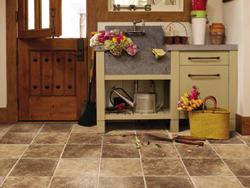Making Money With Resilient - 08 Retailers' Guide
- Home
- News
-
Making Money With Resilient - 08 Retailers' Guide


Resilient used to be considered a cheap alternative for shoppers on a budget. Not anymore. Thanks to recent innovations that have enhanced the performance and visual appeal of both linoleum and vinyl, this category should be positioned to the consumer as a brand new category. In rooms where moisture is an issue—laundry, kitchen and bath—vinyl is one of the best recommendations, especially when you consider the “bounce” factor which reduces leg and back fatigue.
With the new luxury vinyl tile products, the stone and wood styles are so realistic that your customer’s neighbors are going to wish they had chosen this route. And now with the new aluminum oxide wear surface these products perform well enough to be used in commercial environments. LVT is definitely not your “grandmother’s vinyl floors.” When selling these products, be sure to point out the detailed wood graining, random stone veining and marbling. And even more importantly, talk about the cleanability, softness, warmth underfoot, quietness, and the ability to hide scratches and stand up to punishment for very long periods of time.
And with linoleum, you have the added green story, since it’s made with all natural materials. And don’t forget the fact that the color goes all the way through, making it extremely durable.
You should also point out that while resilient should be installed by your professional crews, it’s less costly to install than hardwood and ceramic.
|
TALK INSTALLATION AND MAINTENANCE
|
|
All too often, salespeople wait until after they've shown stunning products to the customer, or worse yet, closed the deal, before talking about installation.
Salespeople should know the basics of how every product is installed. For example, if a customer wants wood and the installation is below grade, your salesperson will have to present engineered wood (or resilient) rather than solid wood. They should always ask the customer what's currently on the floor before they show any product.
Acting as a consultant on the topic of installation is a great way to position yourself as a caring advisor. Be aware upfront that the customer is not focused on this dimension of the project and great care should be taken to properly set expectations without getting caught up in unnecessary details. Many successful retailers have developed checklists they use to walk a customer through the detail.
Well before the installation, someone should visit the customer's home and assess the work to be done. Never install a floor based on customers' measurements or blueprints. Create accurate scale drawings of the rooms you're doing. Notes on the back of an envelope are not professional and don't make customers feel like they're getting their money's worth. Note doors, windows and extreme light sources. Indicate that your installation is the "professional way." Though "professional" installation has its price, mistakes and shortcuts are often even more costly.
Make sure the customer knows about prep work and product acclimation. Also make sure someone can be at the home for a preinstall walkthrough to ensure that the right product is going in the right room.
And the last topic to cover is care and maintenance. This is a great time to review the warranties, offer a discount on the first cleaning, or sell the products required to keep the floor looking brand new.
Now are you finished? No! Ask for a referral. A satisfied customer is your best tool for additional sales.
|
Copyright 2007 Floor Focus
